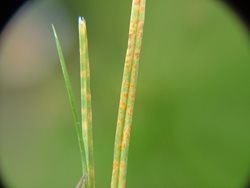Your Cart


Rust generally appears on lawns in late summer and fall when there are conditions of low light intensity and temperatures between 70-80ºF with high humidity. Alternating weather patterns with changes from cool, wet weather to hot, dry weather can also create suitable conditions for the disease. Rust survives on living and dead leaf tissue and in the thatch layer of turf grass. Only when weather conditions become suitable do they begin to cause a concern on the lawn. The disease also tends to be more severe in shaded areas.
Most cool-season grasses are susceptible to rust, with perennial ryegrass being the most susceptible and Kentucky bluegrass being slightly less susceptible. The disease often appears in the form of yellowy-orange flecks on the leaves and tips of grass plants. The spots soon enlarge to form round pustules that rupture to release powdery spores. Because this powdery substance rubs off easily on clothing, shoes, pets, mowers and skin, it is usually fairly easy for homeowners to diagnose.
There are several factors that play a role in the occurrence of rust disease:
- High humidity
- Nitrogen deficiency
- Low light intensity
- Prolonged lawn wetness (often from dew accumulation or watering at night)
- Overcast weather
- Seasonal transitions from cool to hot or vice versa
Slow growing grass and areas of the lawn that are heavily shaded are often affected by rust.
- Provide proper fertilization to improve nitrogen levels in the lawn.
- Book a core aeration service with Weed Man. Aeration improves water penetration to the lawn’s root zone, helping push away disease spores from the turf.
- Increase mowing height and frequency. This will help stimulate turf growth. More growth means more mowing, keeping disease spores at bay.
- Overseed any areas of the lawn that have been severely infected.
- Prune shrubbery and trees to allow more light to reach the surface of your lawn.
- Water in the early morning to reduce periods of leaf wetness.